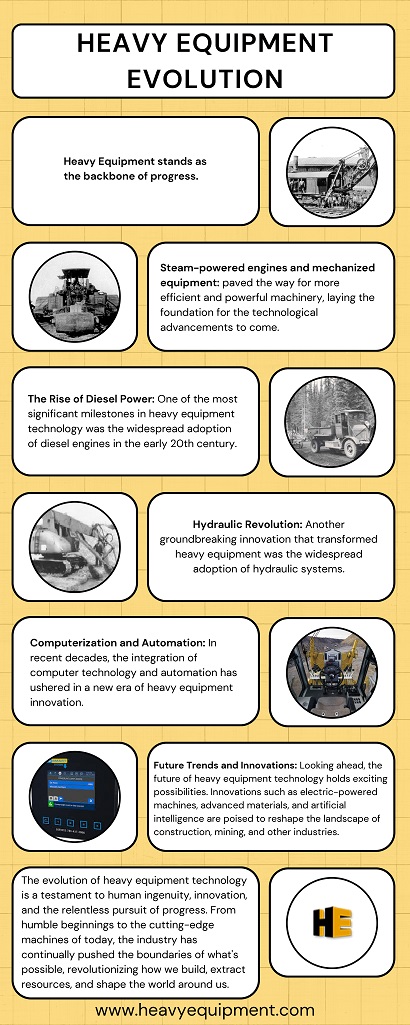Back to The
Hub

Then and Now
A Journey through the Advancements in Heavy Equipment Technology

In the world of construction, mining, and various industrial sectors, heavy equipment stands as the backbone of progress. From towering cranes to earth-shaking excavators, these machines heavy equipment has evolved significantly over the years, reshaping industries and revolutionizing how work gets done. Join us on a captivating journey through the evolution of heavy equipment technology, exploring the engineering marvels, innovative designs, and transformative impacts that have shaped the field.
The Early Years: The roots of heavy equipment can be traced back centuries, with early civilizations using simple tools and rudimentary machines to undertake monumental construction projects. However, it wasn't until the Industrial Revolution that the modern era of heavy equipment began to take shape. Steam-powered engines and mechanized equipment paved the way for more efficient and powerful machinery, laying the foundation for the technological advancements to come.
The Rise of Diesel Power: One of the most significant milestones in heavy equipment technology was the widespread adoption of diesel engines in the early 20th century. Diesel power offered increased efficiency, greater torque, and improved reliability compared to steam and gasoline engines. This shift revolutionized the industry, leading to the development of larger, more capable machines capable of tackling the most demanding tasks with ease.
Hydraulic Revolution: Another groundbreaking innovation that transformed heavy equipment was the widespread adoption of hydraulic systems. Hydraulic technology allowed for precise control, increased lifting capacity, and improved maneuverability, making machines like excavators, bulldozers, and cranes more versatile and efficient than ever before. This hydraulic revolution paved the way for the development of modern hydraulic excavators, which are now indispensable in construction and mining operations worldwide.
Computerization and Automation: In recent decades, the integration of computer technology and automation has ushered in a new era of heavy equipment innovation. Advanced onboard computers, GPS systems, and telematics have enabled operators to monitor machine performance, optimize fuel efficiency, and enhance safety on the job site. Furthermore, the rise of autonomous vehicles and remotely operated machinery promises to further revolutionize the industry, reducing the need for human intervention and improving productivity.
Future Trends and Innovations: Looking ahead, the future of heavy equipment technology holds exciting possibilities. Innovations such as electric-powered machines, advanced materials, and artificial intelligence are poised to reshape the landscape of construction, mining, and other industries. Electric-powered equipment, in particular, offers the potential for reduced emissions, lower operating costs, and quieter operation, paving the way for a more sustainable and efficient future.
The evolution of heavy equipment technology is a testament to human ingenuity, innovation, and the relentless pursuit of progress. From humble beginnings to the cutting-edge machines of today, the industry has continually pushed the boundaries of what's possible, revolutionizing how we build, extract resources, and shape the world around us. As we look to the future, the possibilities are limitless, and the next chapter in the story of heavy equipment promises to be as thrilling as ever.
